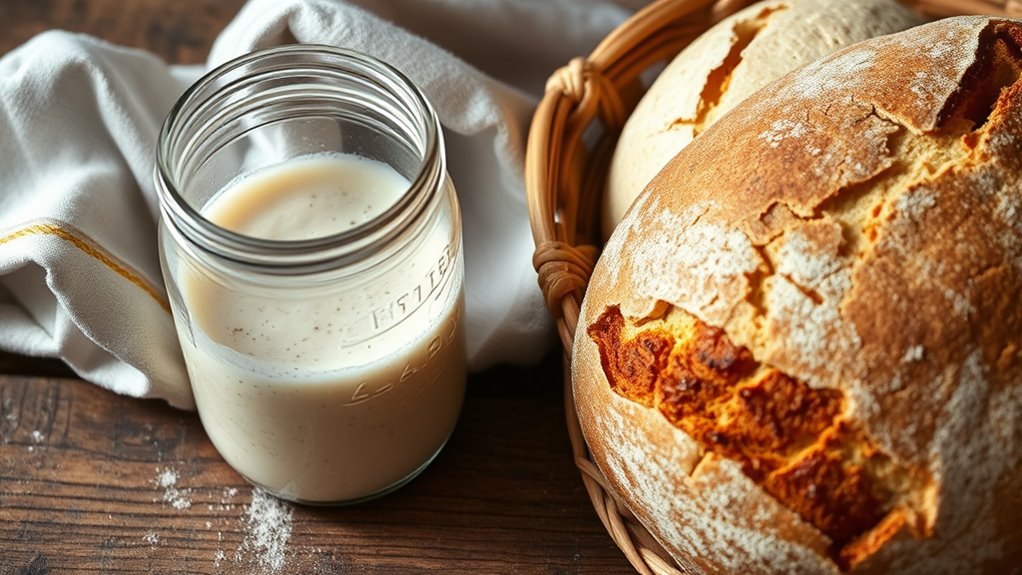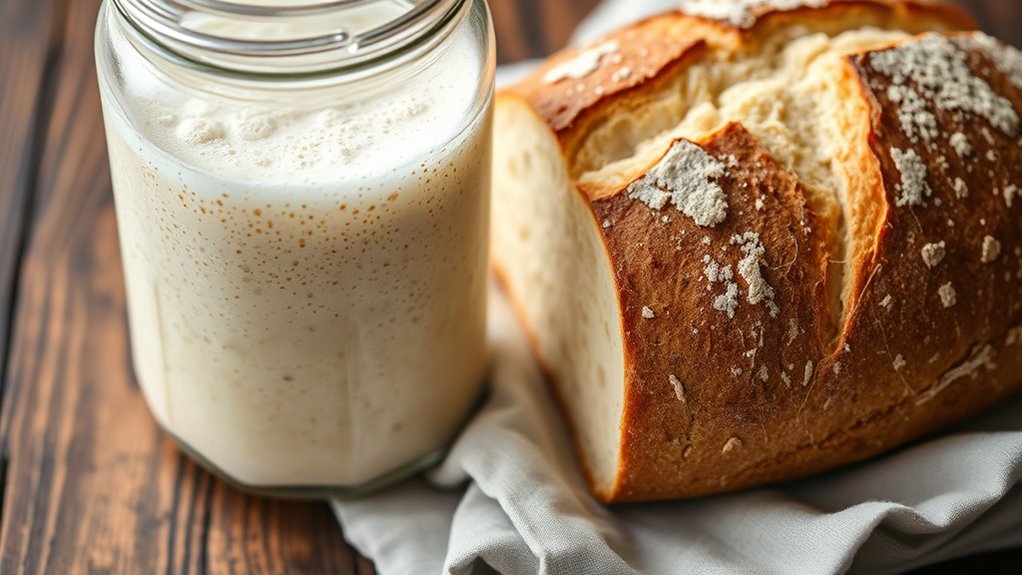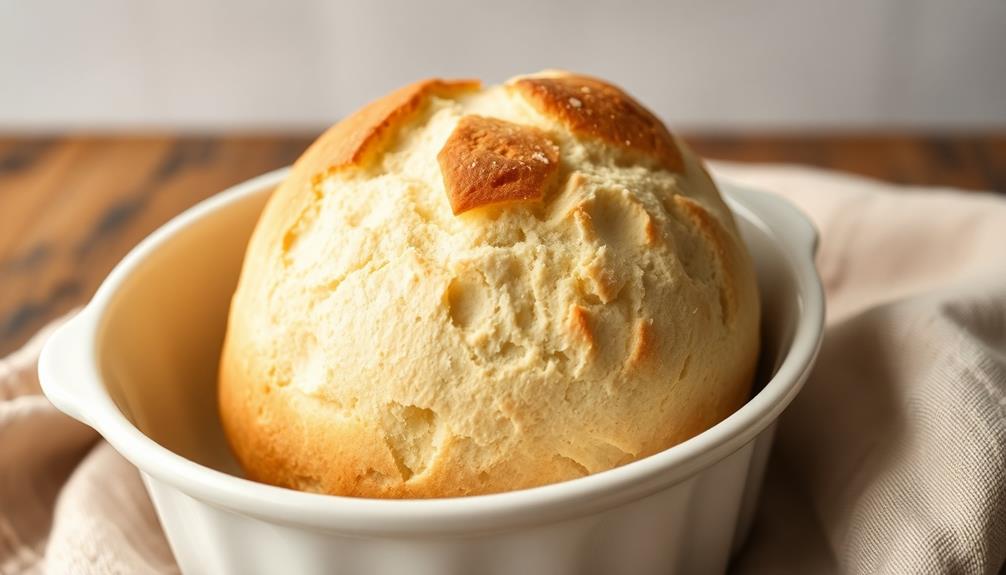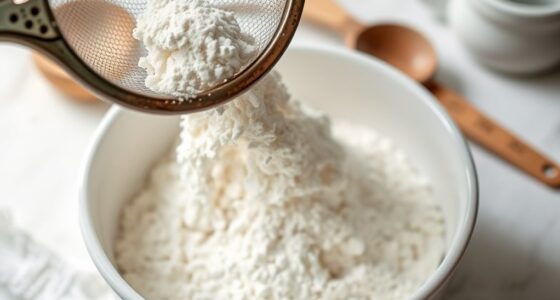To make sourdough bread, you start by cultivating a healthy starter with flour and water, allowing natural microorganisms to develop over time. Regular feeding keeps it active and strong. When ready, mix your starter into dough, then allow it to ferment slowly at controlled temperatures, developing flavor and gas. Proper shaping, proofing, and scoring improve the loaf’s structure and crust. If you want to master each step, keep exploring the key techniques and tips that lead to delicious sourdough.
Key Takeaways
- Develop a healthy starter through regular feeding of flour and water, allowing natural fermentation to establish beneficial microorganisms.
- Monitor fermentation activity and maintain optimal temperature, hydration, and feeding schedule for a strong, active starter.
- Properly knead and shape the dough to develop gluten structure, trapping gases for good rise and texture.
- Control proofing and baking environments, using steam and temperature adjustments to create a crusty, well-risen loaf.
- Observe and adjust fermentation times and techniques to enhance flavor, texture, and overall sourdough bread quality.

Have you ever wondered what makes sourdough bread so unique and flavorful? The secret lies in fermentation science and the baking techniques you use throughout the process. Unlike bread made with commercial yeast, sourdough relies on natural fermentation, where wild yeast and beneficial bacteria work together to leaven and flavor the dough. This complex interplay of microorganisms creates the tangy taste, chewy texture, and distinctive aroma that set sourdough apart from other breads. To master this, you need to understand the fundamentals of fermentation science and how to apply precise baking techniques.
Sourdough’s unique flavor comes from natural fermentation with wild yeast and beneficial bacteria.
The journey begins with creating your starter, which is essentially a living culture of flour and water teeming with wild yeast and bacteria. Developing a healthy starter takes patience and attention; you feed it regularly, allowing the fermentation to develop naturally. As the microorganisms multiply, they produce carbon dioxide, which causes the dough to rise, and acids that give sourdough its characteristic tang. The science of fermentation is critical here—knowing how temperature, hydration, and feeding frequency influence the microbial activity helps you cultivate a robust starter. This knowledge empowers you to control the flavor and leavening power of your bread.
When it’s time to bake, your baking techniques are just as important as your starter’s health. Proper kneading develops gluten networks that trap the gases produced during fermentation, giving your bread its structure. During bulk fermentation, you’ll notice bubbles forming and the dough enlarging, which means the microorganisms are doing their job. Gentle shaping and careful handling preserve these gases, ensuring a good rise in the oven. Also, a proper proofing stage allows the dough to develop flavor further and achieve best volume. Scoring the loaf before baking helps control how the bread expands in the oven, preventing unwanted cracks and ensuring a beautiful crust.
Temperature control throughout every step is crucial. Warmer environments speed up fermentation but can compromise flavor, while cooler temperatures slow it down, allowing for more complex development. Using steam in your oven during baking helps create a crisp crust, another hallmark of well-made sourdough. Learning these baking techniques and understanding fermentation science equip you to troubleshoot issues, experiment with flavor profiles, and refine your skills. The process is both an art and a science, requiring patience, observation, and a willingness to learn from each loaf you bake. Additionally, understanding bicycle tire longevity in storage can help ensure your equipment remains in top condition for every baking session. By mastering these fundamentals, you’ll release the full potential of sourdough, producing bread that is not only delicious but also rooted in natural fermentation processes that make every bite special.
Frequently Asked Questions
How Long Does Sourdough Starter Typically Last?
Your sourdough starter can last indefinitely if you maintain it properly. Regular starter maintenance, including feeding it with fresh flour and water, keeps the fermentation timeline steady. If you refrigerate it, you might only need to feed it weekly. With consistent care, your starter stays healthy and active for months or even years, making it a reliable foundation for delicious bread whenever you’re ready to bake.
Can Sourdough Bread Be Made Gluten-Free?
Yes, you can make gluten-free sourdough bread by using gluten-free flours like rice, buckwheat, or sorghum. To guarantee your bread stays gluten-free, choose dedicated tools and prevent cross-contamination in your kitchen. Follow a gluten-free sourdough starter recipe, and be patient, as fermentation times may vary. This way, you get tasty, gluten-free bread that’s safe for those with gluten sensitivities or celiac disease.
What Are Common Signs of a Healthy Starter?
A healthy starter shows active fermentation activity, evidenced by bubbling and rising consistently. You’ll notice a pleasant, slightly tangy smell, indicating good fermentation, not sour or off-putting odors. It should double in size within 4-6 hours after feeding. If it’s bubbly, has a strong, yeasty aroma, and maintains a stable rise, your starter is thriving. These signs confirm your starter’s readiness for baking, ensuring your bread turns out perfect.
How Do I Troubleshoot a Sourdough That Isn’t Rising?
If your sourdough isn’t rising, don’t worry—fermentation tips can help. First, guarantee your starter is active by giving it more time or warmer temperatures. Check ingredient substitutions—using fresh flour and water can make a difference. You might also try longer fermentation or adjusting hydration levels. Sometimes, a simple tweak in temperature or feeding schedule boosts gluten development and airflow, encouraging better rise in your loaf.
Is It Necessary to Feed the Starter Daily?
You don’t need to feed your starter daily unless you’re baking regularly. For starter maintenance, feeding frequency depends on how often you bake and your storage method. If kept at room temperature, feed it daily to keep it active. When stored in the fridge, you can feed it once a week. Regular feeding keeps your starter healthy and ready for baking, but adjust based on your baking schedule and storage conditions.
Conclusion
Now that you know the essentials, you’re ready to conquer sourdough baking like a true artisan. With patience and practice, your loaf will rise to legendary status—possibly even winning awards! Remember, every loaf you make is a step closer to bread perfection. Keep experimenting, stay curious, and don’t be afraid to get a little flour on your face. Before you know it, you’ll be turning out sourdough masterpieces that could make even the most seasoned bakers jealous.










